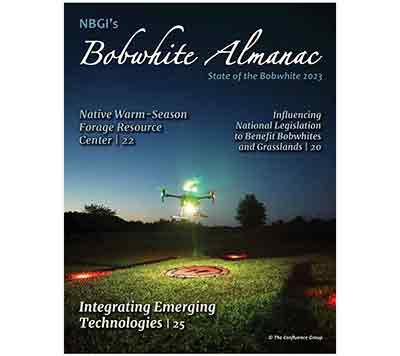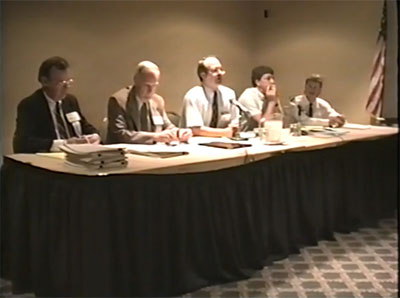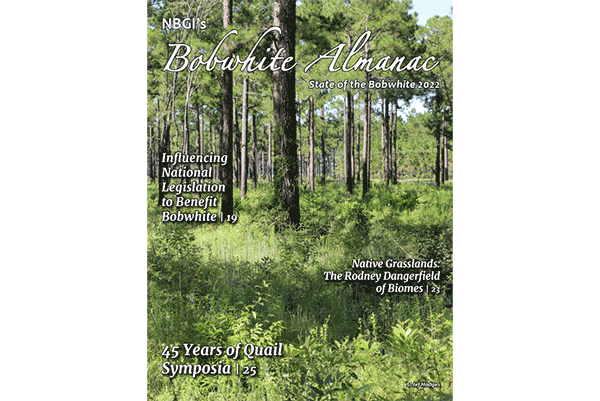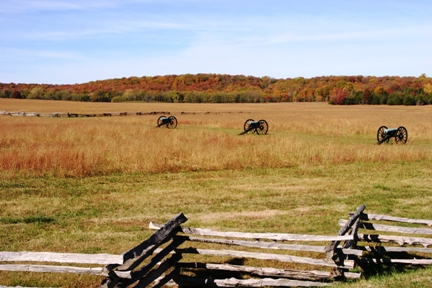
NBGI Releases State of the Bobwhite 2023
For nearly three decades, a voluntary collaboration among 25 state wildlife agencies set a vision for the future to solve a conservation crisis. The

For nearly three decades, a voluntary collaboration among 25 state wildlife agencies set a vision for the future to solve a conservation crisis. The

Thanks to South Texas Chapter of Quail Coalition, we have the historic VHS videos converted to digital of 1992 Quail III Workshop. 4-part series. 1992

It’s been a long and arduous three-year period for the newly coined National Bobwhite and Grassland Initiative (NBGI). From three retirements in key leadership positions,

Applications for the position of director of the National Bobwhite Conservation Initiative (NBCI) are now being accepted with a review of applications beginning April 17
Home runs are uncommon in wildlife conservation policy; but when one happens, it can be a game-changer. Much of the future for large-scale bobwhite restoration

Quail biologists often paraphrase the movie Field of Dreams – “If you build it, they will come” – usually to emphasize the importance of suitable
Area 51 is no match for the range-wide bobwhite decline as fodder for public speculation and skepticism of authority. Even as the most of the nation’s bobwhite experts are actively collaborating on the NBCI, applying the state of the science to develop and implement long-range, habitat-based solutions to begin restoring huntable populations, the president of an Arkansas energy company recently wrote a prominent op-ed in the state paper, asserting (without scientific evidence) his quail solution: reintroducing red wolves, cougars and bobcats. I appreciate that he cares enough about quail to write.
Subsequently, by coincidence of timing, that paper and others printed a spate of positive bobwhite articles and editorials, spurred mainly by a unique new partnership between the Arkansas Game and Fish Commission and the Pea Ridge National Military Park, to create the state’s first official NBCI quail focal area. AGFC’s emerging interest in bobwhite restoration had begun creating a buzz.
The state paper then published a second speculative bobwhite op-ed by the energy company president the week before last, reiterating that the authorities “are wrong about the loss of habitat, and I’m going to tell you, once and for all, why.” The entirety of his evidence:
“There are millions of acres in our state of good quail habitat without a single quail. A comparison between uncultivated acreage in the 1940s and today will show an actual increase in uncultivated acres, as the thousands of small farms of the ’40s, ’50s, and ’60s, were abandoned and the land was allowed to return to nature. If habitat loss were the primary cause, where are the quail that once were plentiful in those millions of acres?”
Already admitting that his original alternative theory may have been off the mark, he now asserts (again with no scientific evidence) that the major culprit in the long-term, state-wide bobwhite decline is feral hogs. His solution: stop funding habitat work, and use that money for hog bounties.
Such uninformed opinions would be just that and little more, except for (1) the overall frustrated, pessimistic and thus impressionable mindset of a broad spectrum of hunters and other bobwhite lovers; and (2) the paucity of compelling visible proof that adequate habitat restoration does work. This combination is ripe for the quail constituency (including hunters and key policy-makers) to either make poorly informed decisions or lose interest and give up entirely.
Meanwhile, the clock is ticking and bobwhites continue to decline. The authorities clearly have something to prove, the sooner the better.
The NBCI’s new (2014) Coordinated Implementation Program (CIP) is a science-based, methodical approach to bobwhite restoration success, designed to clearly demonstrate the connection between suitable habitats and increased bobwhite populations. A long name for the NBCI’s official focal area program, the CIP aims to increase the odds of habitat-based bobwhite restoration successes by (1) providing a framework for siting and designing focal and reference areas in prime locations, (2) requiring states to set meaningful and measurable population goals and habitat objectives, (3) setting near-term timeframes (5 to 10 years) for completion, and (4) requiring science-based standardized habitat assessments and bird population monitoring to document results.
An NBCI goal is for all 25 bobwhite states to have at least one official CIP focal area in the near future. At least 15 states already have or are actively in the process of establishing one or more CIP focal areas. Additional states are considering taking the CIP leap soon.
Establishing an aggressive, standardized and coordinated 25-state quail focal area program is a big challenge; implementing it
 |
|
effectively at local, state and national levels is even more so. The National Bobwhite Technical Committee (NBTC) – the brain trust behind the NBCI – along with the Kentucky Department of Fish and Wildlife Resources and the NBCI just completed a major CIP implementation task last week: sponsoring a train-the-trainer workshop for conducting CIP habitat assessments. About three dozen people from 14 states participated in the training at Shaker Village, KY, the site of one of the nation’s most dramatic and encouraging recent examples of habitat-based bobwhite restoration. (For more information about Kentucky’s 5-year benchmark study of their bobwhite restoration efforts, visit this link: http://goo.gl/6C8QRc.)
The NBCI hired a professional film crew to document the entire workshop and produce a series of online training modules, and now is surveying all participants for feedback and recommendations on other ways to help states move forward with CIP bobwhite restoration areas. Meanwhile, the NBCI’s new Data Analyst, Derek Evans, is on board at the University of Tennessee Institute of Agriculture’s Information Technology Services Department, with a top priority to develop the mechanisms and central databases to store, organize and analyze and report the states’ CIP data.
The history of bobwhite conservation over the past half-century is littered with the debris of failed (i.e., half-hearted, short-term, under-funded, inadequately staffed, poorly planned, unmonitored, etc.) quail initiatives and focal areas. Even if it is obvious to the professional bobwhite managers why those prior efforts came up short, every one of those failures exacerbates the public skepticism about habitat as the foundation of the problem, and undermines the authorities’ credibility. The bobwhite conservation world can afford no more publicly perceived failures.
The CIP will not allay the skepticism and speculation right away, but it is a thorough, scientifically based, adaptive management approach to bobwhite restoration across the species’ range, that increases our collective chances of successes, while providing hard data to help understand and explain when results vary from predictions. The potent show of support and effort for the CIP training last week at Shaker Village was a heartening indicator of the states’ and our partners’ seriousness and will to catalyze more bobwhite successes and minimize or eliminate failures.
We have something to prove.
Quail biologists often paraphrase the movie Field of Dreams – “If you build it, they will come” – usually to emphasize the importance of suitable habitat as the foundation of quail populations. From an NBCI point of view, it and they can have additional and equally important meanings:
– it can mean a vision, a strategy, an initiative, an organized alliance, or a planning tool;
– they can mean partners, manpower, political supporters, or funders.
It is the NBCI vision and unified 25- state strategic plan and its landscape-scale restoration feasibility assessment. It is the growing initiative that is providing unprecedented leadership and national-level capability for implementation. It is the increasingly organized and strengthening alliance of state wildlife agencies, non-government organizations, research institutes, universities, other conservation initiatives, and other state and federal agencies. It is the NBCI’s new Coordinated Implementation Program (CIP), designed to catalyze effective bobwhite focal areas across the states. The broad community of bobwhite conservationists has built all this.
They now are beginning to come, in varied forms, some unexpected.
A chance observation of a 2014 federal public notice for a new vegetation management plan led to phone calls, which led to a meeting, which led to a unique and previously unforeseen formal partnership for bobwhite and grassland bird restoration. The first official NBCI focal area in Arkansas was established last month on Pea Ridge National Military Park (NMP), a 4,300-acre unit of the U.S. Department of Interior’s National Park Service (NPS). See announcement HERE.
I am confident that the NPS had been on the minds of very few NBCI states or quail partners. Likewise, I feel sure that bobwhite restoration has not been on the minds of many NPS employees or administrators. But because the states and the bobwhite community first built it, we have earned the NPS’s attention. They now are coming to be an active partner in a common cause.
Why the NPS?
Due to its overall preservation tradition on national parks, wildlife managers generally overlook the NPS as a potential wildlife conservation partner. But the agency’s national battlefields are different, with a primary cultural mission tied to a specific point in time. The NPS now recognizes that most national battlefields are not authentic representations of the landscapes on which the memorialized event occurred. Vast, mowed fields of fescue are inappropriate, because Civil War-era cattle grazed native forages (fescue hadn’t even been discovered); 19th century forests had been widely thinned out or cut over; fire was common on the landscape; and farm fields were small by today’s standards. In general, the 19th century eastern landscape was bobwhite habitat. 
More importantly, the NPS now is beginning to act to restore more authentic historical landscapes; i.e., bobwhite habitat. The leadership and staff of Pea Ridge NMP plan to eventually restore more than 2,500 acres of the park into native grassland, savanna and open woodland, all of which will be burned frequently. As a result of the new partnership, the Arkansas Game and Fish Commission is prepared to assist on the park, as well as on adjacent acreages of willing private landowners, to create a bigger quail-friendly landscape. Meanwhile, students and faculty from the nearby Northwest Arkansas Community College already are counting quail and songbirds on the park, while the local Benton County Quail sportsman’s club is prepared to contribute additional resources. With so much help, the Park’s restoration vision can be accelerated, improved and elevated into what could become a bobwhite and grassland bird management showcase, consistent with its cultural mission.
With the NPS centennial in 2016, the agency is keen to do some strutting, and is prepared to spend some extra money in the process. Thus, the NBCI already is working with Pea Ridge and regional NPS administrators to expand this unique partnership to the national level. Of all the federal and state land management agencies across the bobwhite’s range, the NPS is emerging as ripe for real partnerships and major progress in a short time. A quick Google count indicates up to a couple dozen national battlefields across several states that might be fertile opportunities. For example, the Pennsylvania Game Commission and Gettysburg NMP just met to begin discussions about establishing that state’s first NBCI focal area using the Pea Ridge partnership as a precedent.
So, why the NPS? In short: (1) it has land; (2) it has native habitat restoration ambitions on battlefields; (3) it has management staff and funds (though never enough); (4) it is a willing partner; (5) it increases the total size of the nation’s quail restoration pie; (6) parks are prime places for public education on why and how native grassland habitat management benefits quail and grassland birds; (7) NPS leadership may ignite interest – or at least a competitive spirit – in other land management agencies that can join the nation’s grassland bird restoration effort.
What about hunting?
Having led with the fanfare, let’s dispense with the elephant: quail hunting on NPS lands is an unlikely outcome of NBCI focal areas on park lands. That reality may initially seem inconsistent with the NBCI’s vision and #1 principle: widespread restoration of huntable populations of wild bobwhites. In a tiny frame of reference, I might agree. In the all-important big picture, however, lack of quail hunting opportunity on NPS lands is a small tradeoff for such a valuable restoration collaboration.
Consider:
– Disturbance and harvest – including the risk of overharvest – will not be a confounding factor in achieving and documenting quail population increases;
– NPS quail focal areas may be used as sources of wild quail for future translocations;
– NPS leadership and partnerships – and especially quail population success – can stimulate interest and action by surrounding landowners, where hunting likely will occur, resulting in an expanding landscape-scale effect;
– Absence of public hunting on NPS lands eliminates the political difficulty of mediating among conflicting and competing sportsmen constituencies.
Given the current situation of declining bobwhite populations in every single state in which the species occurs, quail folks need more successes in the near term, wherever we can find them. The NPS is capable of making real conservation contributions toward near-term, habitat-based bobwhite success stories.
Bobwhite folks across 25 states built it, and now they are coming … almost as if we had planned it that way!
We both smiled brightly for the first time since he left.
The weekend visit from our son, Patrick, was welcome and very pleasant; but short. We are exceedingly fortunate that we actually still like both our college-age kids; they, in turn, still seem to appreciate us. But there is a very real downside of such a mutually enjoyable relationship. His return to Knoxville on Sunday for the final weeks of the University of Tennessee’s spring semester left behind a melancholy void.
I normally can never find time to do all the things I want to do.That day, I couldn’t seem to find anything I wanted to do with all the time. Only the threat of overnight storms finally moved me off the deck swing and over to the mower in the half-finished yard.
Just as I reached the mower, I heard a sound so unexpected it didn’t even register at first:
Bob WHITE!
The second call stopped me in my tracks. The third made me whip around to see if the mockingbird was playing a cruel trick. We hadn’t heard a singing bobwhite on our property in three years, since a series of nasty ice storms had hammered the local population. At the fourth call, I ran around the corner back toward the deck just as my wife, Sheryl, was hopping down from the deck. We both shouted at the same time: “A bobwhite!”
We stood for the next minute or so, just listening, enjoying and trying to pinpoint the bob’s location. Just that quickly, the mood brightened and the day felt good again.
We both smiled brightly for the first time since he left.
April 22, 2014
More than a decade ago, the bobwhite folks reached consensus that we needed an effective voice in Washington, DC to represent quail habitat needs in federal conservation policy. Too many longstanding problems and missed big opportunities for quail had been rooted in uninformed decisions made in Washington.
During 2009, NBCI and our partners were pursuing two funding opportunities simultaneously: approval as a “Keystone Initiative” of the National Fish and Wildlife Foundation, and a Multistate Conservation Grant. Both avenues aimed to establish a DC policy position for the NBCI.
In the meantime, two different operational models for that position had been proposed.
(1) The NBTC Agriculture Policy Subcommittee (led at the time by Bill White and Chuck Kowaleski) developed a thoughtful recommendation that the NBCI create a technical liaison with the USDA Farm Service Agency (FSA), housed within the very FSA division that administers the Conservation Reserve Program – the Conservation and Environmental Programs Division (CEPD). At the time, the FSA Deputy Administrator for Farm Programs (DAFP) had a vibrant relationship with the wildlife community and vigorously supported the liaison concept as a way of building relationships and helping FSA improve the CRP’s effectiveness for quail.
(2) The other model for a full-time DC quail position – based largely on my personal DC experiences from 1991-1997 as a full-time agriculture conservation policy coordinator with the Wildlife Management Institute – was an all-purpose DC quail habitat representative, a professional quail expert interested in policy, who can tolerate DC long enough to become effective.
We opted to try the Ag Policy Subcommittee’s FSA Liaison model. Our 3-year MSCG proposal was funded, and in summer 2010 the NBCI was privileged to hire Bridget Collins, the one person in the U.S. at the time who was a (a) quail expert, (b) interested in policy, and (c) didn’t mind working in DC. Shortly after she started working inside CEPD, the politically appointed DAFP who had been so supportive left the agency. Two years later, Bridget was hired by the Association of Fish and Wildlife Agencies as their new Agriculture Conservation Coordinator. For the last year of the position, the NBCI was fortunate to find and hire Kyle Brazil, a quail expert with an interest in conservation policy who was willing to move to DC to give it a try. Kyle finished the term of the grant in December 2013 and left DC to go back to southeast Texas to work for the Wildlife Habitat Federation.
Bridget and Kyle did valuable service for the NBCI in a challenging position that very few of us quail folks could handle. They earned our respect and gratitude. Both made real contributions by providing technical input on key practices and proposals. For example, Kyle created and led a national coalition supporting increased USDA use of native vegetation, and shepherded the NBTC’s proposal for center pivot corner eligibility in CP33 farther than anyone or any group had ever been able to. Some 250,000 acres (the unfilled CP33 allocation) of quail habitat opportunity is at stake in the bobwhite states that have center pivot irrigation. Every previous proposal over the last 20 years for pivot corner eligibility in a continuous CRP practice had been immediately and firmly rebuffed by FSA. But right up until he left, Kyle had been able to negotiate the concept to the verge of internal acceptance by FSA. The matter remains on the verge, unfinished, but without our NBCI person in DC tending to it.
Fortunately, a majority of the bobwhite states are stepping up right now to provide increased, stable funding for the NBCI for the next 3 years. This vote of confidence from the states makes it more likely that we will be able to refill the DC position sooner than later.
Meanwhile, this pause allows reflection. The concept of a key federal agency liaison offers intriguing possibilities, but also comes with myriad limitations and sensitivities. We knew from the beginning that this experiment could turn out to be a brilliant stroke of genius or a colossal failure. It ended up somewhere in between, for a variety of reasons, but the bottom line is it did not meet our needs. On the bright side, the bobwhite community now has a much better understanding of why things are the way they are with CRP, and has made some valuable connections within USDA.
The NBTC Ag Policy Subcommittee and Steering Committee currently are mulling over the lessons learned from the last three years, and deliberating on how better to set up and manage the position once we are able to refill it.
Stay tuned for updates.
February 5, 2014